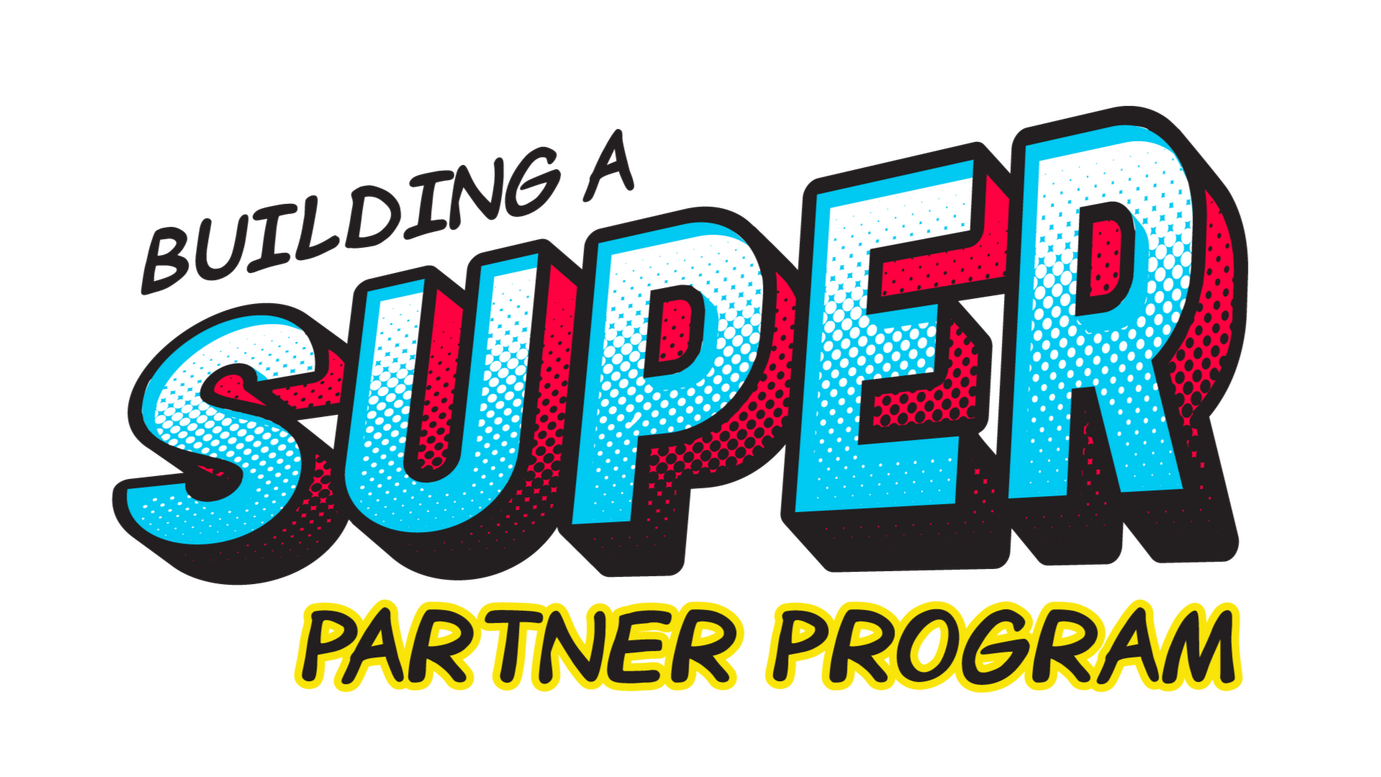
Unleash the Power of Partnerships in your Organization
Welcome! This site is a primer on deploying a referral and/or service provider partner program into an existing SaaS business.It will also be helpful to those working in channel marketing (or sales) who want to grow their programs. This site doesn’t contain all the answers, but it will help to give readers an idea of the things to consider when launching a channel program.Let's get started!

Learn more about your friendly neighborhood channel marketing guy (and author of this site) Joe Ribaudo.
Table of Contents

© Joe Ribaudo, 2023. All rights reserved.
Up, up, and away!
Introduction

It’s been a tough year in the SaaS space—inflation is rising, debt is becoming more expensive, and workforces continue to be trimmed from the hiring boom of the pandemic. It’s challenging out there for anyone currently looking for work in tech... and for those still with a job, what’s left of marketing and sales budgets might not be anything to brag about.But a lot of SaaS companies could be missing out on a cost-effective way to expand their local reach, amplify their brand presence, and grow their sales force.Yep—I’m talking about partnerships.While your inside sales team toils away on closing individual deals, a strong network of partners can be deployed to sell on your behalf, 24 hours a day... 7 days a week... all over the globe. These partners can help you to reduce end-user churn, create value for your shared customers, and drive renewals!How much revenue do you think you’re missing out on by not having a partner channel?There have been many handbooks written about the benefits of the channel (PartnerHacker’s Anthology on Ecosystems is an incredible resource), so I won’t dare get into too much detail here.What follows is a digestible primer on what types of things a SaaS company should take into consideration as they think about implementing a partner channel. I’ll primary focus on referral and service provider programs in this guide.Dipping your toes into channel doesn’t have to be like lifting a bus over your head. There’s a way to start off with fairly limited resources to see if it’s right for your business—but know that doing so does require a level of time and commitment from your organization.
© Joe Ribaudo, 2023. All rights reserved.
Finding Super-Friends at Work
Creating Internal Alignment

The most important thing you can do to set yourself up for success on your channel journey is to create internal alignment. This starts from the top, and it should be treated as a strategic initiative with ample runway to take flight. Give the partner team a seat at the big table to ensure that your leaders are bought in and telling the story of the channel:“Our company is choosing to invest in starting a partner channel because we feel that it is a cost-effective way to unlock new business at a local level, expand our brand’s presence, and provide more value to our joint customers.”It’s a pretty simple story that doesn’t have folks running for the hills when they hear the term “channel partner”. It’s not Kryptonite, after all!One way to do this is to designate a channel champion within your partner organization—usually a member of the partner sales or marketing team—to be that storyteller for the business. (Don’t forget to get them in front of your new hire classes, either.)There’s often a misconception that channel work is wildly different or more complicated than what’s being done on the direct side of a business. Most of the reporting, resources, training, sales techniques, processes, et cetera that you already have in place, can largely be re-purposed to work for your partner team.Additionally, including the partner team on brand-level marketing program planning and product releases will help you avoid wasting time to backtrack and will help to create stronger alignment between direct and indirect.Partner teams also spend a lot of their time working on the speculation of new business, so set that expectation with the leaders in your organization. We’ve all been there: a partner onboarding call goes really well, only for that partner to ghost you when it comes time to bring in new business (we’ll get to that later).In any case, this is most definitely a journey—and one that’s worth the travel if done correctly.
© Joe Ribaudo, 2023. All rights reserved.
Stocking your utility belt
Operational, reporting, and marketing considerations

Before you invite prospective partners to join your program, you’ll need to spend some time thinking about the core systems, reports, and resources that will support it. The good news? Your existing tech stack can very likely support the operational needs of a partner channel.Program Positioning
Define how you’ll talk about your partner program in-market. Why would someone want to partner with your organization? This positioning doc will serve as the primary reference source for the partner acquisition materials you’ll soon create.Partnership Agreement
Draft a boilerplate agreement for your partners to sign upon joining you as a partner. Ideally, these agreements are tracked and stored in your CRM so you can refer back to them.Partner Profile
Develop a form for partners to fill out that will provide you with a list of contacts on the account (primary, billing, technical,marketing-related), a business profile (to include links to their digital properties), and any events they might be attending or sponsoring (which is a great way for you to think about where you should be).Task Management
Provide your partner team with a way to track their program-related work, as well as the partner-level co-marketing that’s to come. Tools8 like ClickUp, Monday.com, or Trello will help keep folks focused and provide visibility into their work for the entire team.Program Acquisition Resources
Stand up a landing page on your site to provide information about your partner program, including an application or RFI form. Add logos and testimonials from deployed partnerships as you get them. Ensure that the page is easy to discover on your site.Develop a 1-pager to speak to the value of your program, and a customizable slide deck that your partner managers can use to pitch the program. More slides are better for this—lead off with a company overview, then the value proposition of the program, a list of partner benefits, a timeline of what to expect, and several slides devoted to your product(s). The partner manager will have a lot to choose from as they tailor the deck to fit a conversation with a prospective partner.Internal Enablement
As you begin to create resources, processes, and training materials, make sure it’s all easily searchable and accessible to your internal teams. Tools8 like Microsoft SharePoint, or Google Sites are easy to deploy and update internally.Partner Portal
As you scale, consider investing in partner portal software. These systems provide your partners with a self-serve source for everything they’ll need to be successful as your partner.Many solutions like Impartner, ZiftOne, Allbound, or PartnerStack can be customized with modules like content repositories, co-brandable content, reporting, deal registration, and more. If you’re looking to quickly scale, prioritize your investment as these systems can create a lot of efficiencies internally.Systems and Reporting
Define pipeline stages to track the journey from prospect to partner; build these stages into your CRM.
Create a lead capture form for prospective partners to fill out—this form will need to carry the data into your CRM.
In your CRM, differentiate your partners (and the accounts they refer to you) from your direct customers. This will help you generate partner-specific reports and mailing audiences later.
Ensure partners’ contact information is syncing between your CRM and your email system so that your partner marketers can email your partners. Don’t forget to create a subscription center to honor any opt-out requests.
Provide your partners with a way to refer business to you (i.e. a referral link unique to each partner) and/or a way for partners to register deals with your company. Will your inside sales team close these deals on behalf of your partners, or will the partners be responsible? This could get complicated if your brand has several products—make sure that it’s easy for your partners to sell for you!
Depending on how you want to reward your partners, work with your operations, legal, and billing teams to automate as much of the payout process as possible. You’ll need to create a process to capture direct deposit information and any required tax forms. Many partner portal systems include this functionality, charging you a nominal transaction fee on payouts.
Develop reporting to show where your partners are coming from—e.g. an event, online ad, internal referral, and so on. Track applications/RFIs, deployments, and the partner’s lifetime productivity. This helps your partner marketers know what sources yield your best, most productive partners.
Additional reporting should provide visibility into productivity (revenue, new customers, etc.) at the channel level, at the partner level, and however you determine to organize your partner sales/account management team. Also consider developing reporting to show time to first sale—this will help you to track the efficiency of your efforts and effectiveness of your onboarding.
© Joe Ribaudo, 2023. All rights reserved.
Partner Team: assemble!
Staffing up your partner team

Sales and marketing teams... there’s something about this dynamic that typically creates friction. Their roles are different, their KPIs are different, they likely report into different parts of the business, and their compensation plans are different. I’ve been at companies where these relationships are strained, and I’ve been at companies where these teams work well together.It’s worked well where a “Partner Team” has been formed. Most cases, it’s an unofficial term for the various teams that focus solely on partners, regardless of what part of the business they report into—a way to group folks together and rally them around shared goals.So who should be on your partner team?
If you’re just starting out, look at the teams you already have in place to see if functional experts can each extend a little bit of their current role to support the needs of the channel.Who are some of your strongest sales folks? Can they take on partner account management part time to start out? Can they be enabled with a list of prospective partners to call out to with the goal of deploying them into the program? As your partner efforts progress, promoting sales AEs into partnership roles is often seen as a promotion, so the byproduct of this is creating an alternative career path for these folks.You want to look for reps that can handle complexity, build relationships over time, and think strategically with the partner to help them be successful. You need these folks to be great communicators who can coach your partners, and continually sell the value of partnering with your company.On the marketing side, this will likely require folks to think more broadly about their roles and how to incorporate the channel. For example, if a brand campaign is launching, have this team think about how the assets can be channelized or built upon to be used by partners. Your acquisition team can play a role in helping you find and reach your ideal partner prospects if given guidance on who to look for.Is your inside sales team supported by an enablement team? If so, look to expand the breadth of the enablement team to help train and enable partner managers and partners with product and sales (sell-through) training.For support roles, your channel champion and enablement team can work to train your existing support organization to field support requests from partners (and their client accounts). It’s important to prioritize these support requests—remember, these partners are out selling on your behalf, so don’t make them wait on hold.Does your site have a user community or external-facing knowledge base? If so, add a “Partners” section to provide your partners with a self-serve way to get their questions answered after-hours.A sales engineer may also be needed to give product demonstrations (by request), or to tackle any of the more technical questions that might not be suitable for your support team.In the beginning, your partner team may be comprised of functional experts providing fractional support. As you begin to formalize the program, consider making some of these roles official by dedicating them fully to partnerships.You will likely need to consider adding marketing muscle to work directly with partners on co-marketing programs. This can get complicated quickly (many partners with diverse requests and strategies), so it should be one of your first dedicated hires.
© Joe Ribaudo, 2023. All rights reserved.
Light the bat signal
Finding your first partners

As we covered in the last section, leveraging your current acquisition team can help you source new partners to your business. The functions here are similar to how they’re already helping you fill your direct lead funnel—it’s just a different audience. Have a budget in mind, and come to them with a profile of your ideal partner.To help you build this profile, look at the businesses partnering with your competitors. This can give you clues as to what types of businesses you’re looking for. Take a look at industry trade organizations as well—in both instances, you’ll likely find directories of these types of businesses.Look inward! You very likely have customers who have purchased your product on behalf of a client. If you’re looking for referral and/or service provider partners, pull a list of your customers and look at their company names—do any of them contain variations on “agency, solutions, services, or consultant”?Look for accounts that have the same contact information or billing information—that’s another clue as to who may be setting up accounts on behalf of a client. You might also perform a search in your sales team’s call tracking software (e.g. Gong) to see if keywords like “partnership, services, referring, or client” have come up in conversation.Have your SDRs and AEs dig a bit deeper when handling new business leads, too. It’s sometimes as easy as asking, “Are you looking to purchase for your own business, or set this up on behalf of a client or customer?” Include a similar question/check box in your purchase flow to capture any prospective partners.Another source of prospective partners can be via your customer advocacy program. Who are your super-users? Do you have a customer referral program? Give your employees a way to refer partner leads over to your team—set up an internal bounty or SPIF program to reward them for passing these leads to you.Finally, what industry events in your space might attract attendees that are a match for your ideal partner profile? If you can’t sponsor the event, attend it and bring your program sell-sheets. If your company exhibits anywhere, make sure your events team stocks your booth with program collateral.
© Joe Ribaudo, 2023. All rights reserved.
Charge!!!
Creating a great onboarding experience

You’ve done a lot of work to get to this point—putting countless hours into systems, staffing, and partner acquisition... don’t lose the partner now that they’ve been deployed!Your onboarding experience is an extension of your brand, so the experience should be on point. You get one chance to make a great first impression on this partner—you want it to be so good that they’re excited to start selling for you!Welcome your partners into the program—set up an onboarding email cadence, trigger a swag package to be mailed to the primary contact(s), and work with your partner on ways that you can jointly announce the partnership (e.g. social media, or a joint press release).In your onboarding cadence, provide them with the basics—a downloadable onboarding guide, a prescriptive checklist of actions to take, a list of their points of contact inside your organization, links to product training and sales enablement, and guidance on any partner-facing systems (e.g. a partner portal). Set the expectation of how you’ll be communicating with them, and what the next 30/60/90 days will look like.This cadence should be accompanied by a series of calls from their dedicated account manager—to see if the partner has questions and get the ball rolling on their first co-marketing initiative.Bring your partner marketing folks into the first few calls with your new partners. This will help them understand the partners’ goals and get them thinking about the types of joint programs that can be executed. It also puts this work on their radar, allowing them to prioritize these deliverables appropriately.Do what you can to make this a consistent, repeatable, and scalable motion for your team. A former CEO of mine once told me, “feedback is a gift,” so don’t be shy about asking partners how their experience is going!
© Joe Ribaudo, 2023. All rights reserved.
Meow-tivating your partners
Incentives and Service Opportunities

There are a variety of ways that you can reward your referral and service provider partners for generating SQLs or new business opportunities. Whatever approach you decide to take, think of this from your partners’ point of view—is it easy for them to understand, and is it enough to make them want to do more with/for you?Financial Rewards
You might consider rewarding service providers differently than referral partners who are just passively recommending your products/services. You might elect to offer new account bounties right away, or even add a condition that the account must be in good standing for X-days to reduce the risk of early customer churn.Some programs just go straight to a revenue share model—I’ve seen some provide a flat revenue share for the life of the account, and others calculate revenue share based on the total invoice for the initial contract term and reduce the revenue share for renewal terms.As your program matures, you may even consider adding a tiered system based on sales volume or annual recurring revenue. Again, most partner portal software can help you administrate the tiering process.Lead Passing & Services
If your company provides professional services to your customers, it’s likely that the services only go so far. If that’s the case, this creates an opportunity to match the customer with one of your partners to have the partner deliver those services. This can be a manual process, but can be simplified if you decide to restrict this perk to partners of a certain tier (or Certification status). Additionally, you might just send these customers to a public-facing partner directory for them to choose a provider themselves.Service revenue is always a strong motivator, however some partners need help forming these packages and pricing models. A partner once told me, “revenue share is my margarita money... I make the real money by doing the work for my clients.” I think that’s true in a lot of programs. A good partner program will provide guidance to their partners on how to package, price, and deliver those services to your shared customers.You may also consider passing new business leads to your most qualified partners for them to close. This method requires a bit more development work in order to build this pipeline, but it takes the selling off your plate.Market Development Funds (MDF)
Another way to financially motivate your partners is to develop an MDF program—where your business will help partners fund their demand gen. If you’re just starting out, consider holding this idea until your program matures. Still, some partner portal systems offer a built-in MDF module to help you administrate this process.Co-Marketing
As part of your program value-add, don’t forget to explain the co-marketing opportunities that are available to qualified partners, like:
Including your partners in brand programs, case studies, or inviting them to speak to your customers and prospects as part of an event or webinar.
Inviting your partners to co-author articles for your blog.
Periodically featuring your partners in your company’s social posts.
Adding your partners’ information into a public-facing partner directory—add badges to show the partners’ tiers and Certification status.
Allowing your partners to contribute to your Community site to showcase their subject matter expertise. (But watch that they don’t get salesy!)
Develop case studies or training modules featuring your most successful partners—use these to enable your other partners with these best practices. A rising tide raises all ships, after all!
Bring your partners to your company’s headquarters for focus groups, round tables, Q&A sessions with your employees, or to meet their peers.
Recognize their sales efforts at the end of the year through a competition or “best-of” list.
Delight your partners by sending them swag to recognize a partnership anniversary, business milestone, or to celebrate a closed-won deal.
© Joe Ribaudo, 2023. All rights reserved.
Swing by once in a while
Ongoing partner engagement

Your partner’s first 30 days are a critical time to get them enabled and successful, but your work doesn’t stop there. Ongoing engagement will help to reduce partner churn and keep your brand top of mind. Consider implementing some of the following ideas:
Have your account managers hold regular Quarterly Business Reviews (QBRs) with their partners. Discuss their goals, celebrate wins, and make plans for the future.
Hold regularly-scheduled webinars or events for your partners to hear about new products, share release notes, or catch up on program changes. Make these as interactive as possible.
Publish a partner program newsletter to summarize anything that’s important for your partners to know.
Conduct regional meetups for your partners to network with each other and get face time with their account managers.
Field pulse surveys after key milestones like onboarding, the completion of a Certification program, and so on.
Field an annual partner satisfaction survey to help you stay on top of trends or changes in your partner base. Summarize these findings, and let your partners know that their feedback has been heard and acted upon. Again, feedback is a gift!
© Joe Ribaudo, 2023. All rights reserved.
About the Author

Joe Ribaudo began his marketing career around 2000, when he got his first job in direct mail (yikes!), working in a variety of industries honing his skills ever since. From strategy and marketing analytics, to creative, branding, events, communications, and demand gen—he’s been around the block once or twice.Joe has spent the past 10 years in the world of SaaS channel programs growing the partner businesses at Constant Contact and Validity, Inc.Reach out to Joe at www.ribau.do, or via the form below.
© Joe Ribaudo, 2023. All rights reserved.
Download the guide

Download "Building a Super Partner Program" as a PDF, and you'll get a bonus checklist summarizing each section, plus a list of KPIs that are important to track as you get started in the channel!
© Joe Ribaudo, 2023. All rights reserved.









